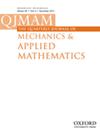Rivulet flow round a horizontal cylinder subject to a uniform surface shear stress
IF 0.8
4区 工程技术
Q3 MATHEMATICS, APPLIED
Quarterly Journal of Mechanics and Applied Mathematics
Pub Date : 2014-11-01
DOI:10.1093/QJMAM/HBU018
引用次数: 11
Abstract
The steady flow of a slowly varying rivulet with prescribed flux in the azimuthal direction round a large stationary horizontal cylinder subject to a prescribed uniform azimuthal surface shear stress is investigated. In particular, we focus on the case where the volume flux is downwards but the shear stress is upwards, for which there is always a solution corresponding to a rivulet flowing down at least part of one side of the cylinder. We consider both a rivulet with constant non-zero contact angle but slowly varying width (i.e. de-pinned contact lines) and a rivulet with constant width but slowly varying contact angle (i.e. pinned contact lines), and show that they have qualitatively different behaviour. When shear is present, a rivulet with constant non-zero contact angle can never run all the way from the top to the bottom of the cylinder, and so we consider the scenario in which an infinitely wide two-dimensional film of uniform thickness covers part of the upper half of the cylinder and "breaks" into a single rivulet with constant non-zero contact angle. In contrast, a sufficiently narrow rivulet with constant width can run all the way from the top to the bottom of the cylinder, whereas a wide rivulet can do so only if its contact lines de-pin, and so we consider the scenario in which the contact lines of a wide rivulet de-pin on the lower half of the cylinder.受均匀表面剪应力作用而绕水平圆柱体流动的小溪
研究了在规定的均匀方位角表面剪应力作用下,沿方位角方向缓慢变化的流场沿固定的大水平圆柱体的定常流动。特别地,我们关注体积通量向下而剪切应力向上的情况,对于这种情况,总有一个解对应于至少沿圆柱体一侧的一部分向下流动。我们同时考虑具有恒定非零接触角但缓慢变化宽度(即去钉住接触线)的小溪和具有恒定宽度但缓慢变化接触角(即钉住接触线)的小溪,并表明它们具有定性不同的行为。当存在剪切时,具有恒定非零接触角的流线不可能从圆柱体的顶部一直流到底部,因此我们考虑一个无限宽的均匀厚度的二维膜覆盖圆柱体上半部分并“断裂”成一个具有恒定非零接触角的单一流线的情况。相反,一个足够窄的恒定宽度的小溪可以从圆柱体的顶部一直流到底部,而一个很宽的小溪只有在它的接触线断开时才能这样做,因此我们考虑一个很宽的小溪的接触线断开在圆柱体的下半部分的情况。
本文章由计算机程序翻译,如有差异,请以英文原文为准。
求助全文
约1分钟内获得全文
求助全文
来源期刊
CiteScore
1.90
自引率
11.10%
发文量
14
审稿时长
>12 weeks
期刊介绍:
The Quarterly Journal of Mechanics and Applied Mathematics publishes original research articles on the application of mathematics to the field of mechanics interpreted in its widest sense. In addition to traditional areas, such as fluid and solid mechanics, the editors welcome submissions relating to any modern and emerging areas of applied mathematics.

 求助内容:
求助内容: 应助结果提醒方式:
应助结果提醒方式:


